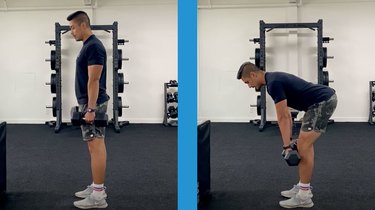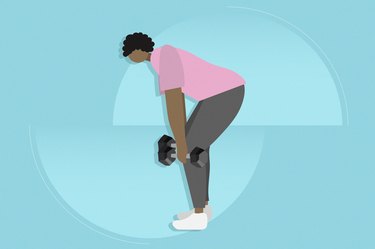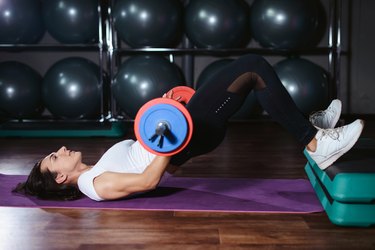

Deadlifts come in more variations than just about any other exercise. Why? Options let you customize your workouts to your body and needs. They also help build muscle and more well-rounded strength.
Enter, the stiff-leg deadlift (SLDL). Also called a straight-leg deadlift (even though it doesn't involve fully straightening your legs), it's a great variation for anyone who really wants to hammer their hamstrings or has great lower-body flexibility.
Video of the Day
- What is the SLDL? It's an exercise that involves pushing your hips back and slightly bending your knees while holding weights, and then standing back up.
- What muscles does a stiff-legged deadlift work? This exercise mostly works your hamstrings, glutes and lower back, according to Jereme Schumacher, DPT, a California-based physical therapist. You should feel this in the back of your thighs, hips and lower back.
- What's the difference between a stiff-leg deadlift vs. Romanian deadlift? Romanian deadlifts involve bending your knees a little more than a SL version does, Schumacher says. So, straight-leg deadlifts require a little more flexibility in your hamstrings and stability in your back.
- What's the difference between a stiff-leg deadlift vs. conventional deadlift? When you do a conventional deadlift, you bend your knees even more than you do with an RDL, so you lower the weight all of the floor with each rep. But keeping your knees straighter limits how far you can lower the weight.
- Who can do the SLDL? Everyone can benefit from this exercise, Schumacher says. But people with lower-back pain should start with very light weights (10 pounds) or do the Romanian deadlift instead.
How to Do the SLDL With Perfect Form

Watch the Full Tutorial
- Stand with your legs hip-width apart and hold a pair of dumbbells in each hand in front of your thighs, palms facing your body. Brace your core.
- Push your hips back and lower your torso, allowing a very small bend in your knees.
- Keeping the weights close to your body, lower the weights until they're at about shin height.
- Pause, then push through your heels and squeeze your glutes to stand up tall.
Tip
You can also barbell or kettlebell stiff-leg deadlifts. But light dumbbells are best for beginners, according to Schumacher.
4 Stiff-Leg Deadlift Benefits
1. Muscle Balance
Considering most of your day-to-day activities happen in front of your body (your anterior chain), it's easy to forget about the muscles of your backside (your posterior chain). This can cause muscle imbalances and, in the long run, lead to poor posture and back pain.
The SLDL gives your hamstrings, glutes and back the attention they deserve, Schumacher says.
2. Total-Body Strength
While this move does focus on the muscles at the back of your body, it also strengthens from head to toe. Deadlifts work multiple joints and muscle groups at the same time, according to the American Council on Exercise (ACE).
Compared with exercises that target one muscle group, compound moves more effectively improve total-body mobility and muscle health.
3. Back Health
Having a weak (aka untrained) back puts you at risk of injury. Fortunately, since this exercise keeps your legs relatively straight, you rely more on your lower back strength to complete the move. This builds more strength and stability in the area, he says.
You also work the deep core muscle, known as your transverse abdominis (TA). This works like an internal corset or weight belt, helping support your spine.
3 Common Mistakes to Avoid
1. Lowering Too Far
Dropping it low makes it impossible to keep a strong, neutral spine. And when you lift and lower weights with a curve in your upper or lower back, you exponentially raise your risk of back pain and injury. You also lose a lot of the torso-strengthening benefits of the exercise.
Fix It
Only lower the weights as low as you can go with a neutral spine, Schumacher says. This is generally to your shins.
2. Relaxing Your Shoulders
If you don't actively squeeze your shoulders and lats during DLs, you automatically curve your upper back. This puts you at risk of back and shoulder pain. Also, when you let your shoulders and upper back go limp, you forfeit the upper-body strengthening benefits of DLs. Yep, they work your upper body too.
Fix It
Before lowering the weight, squeeze your shoulder blades down and back to firm your shoulders, Schumacher says. Maintain this position throughout the entire exercise.
3. Holding the Weights Too Far in Front of You
As you lower and raise your weights, keep them close to your legs, Schumacher says. The farther they move in front of you, the more stress (and not the good kind) they put on your lower back. They also work your glutes and hamstrings that much less.
Fix It
As you move from standing to hinged, keep the weights about an inch from your legs, Schumacher says. Pull your shoulder blades down and back to help keep the weights from moving too far away.
4 Challenging Variations to Try
1. Eccentric
When you lower your weights slowly (eccentrically), your muscles stay under tension for a longer amount of time. This increases the strength-building benefits of the exercise, Schumacher says. Try lowering your weights for a 4-second count.
With your keep hip-width apart, step one leg slightly behind the other. Shift your weight into your front leg and let your back heel pop up. Consider that leg your balancing kickstand. Lower and stand back up using your front leg. Do all reps, then switch sides.
3. Single-Leg
Challenge your balance and stability by using only one leg at a time. As you lower into each rep, let one leg raise behind your body. Balance on your opposite leg. After you return to standing and do all your reps here, switch sides.
4. Offset
Instead of holding two weights, test your core strength by doing the move with one dumbbell or kettlebell in one hand. Resist its sideways pull.
Was this article helpful?
150 Characters Max
0/150
Thank you for sharing!
Thank you for your feedback!

